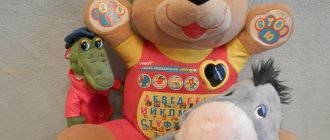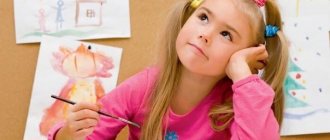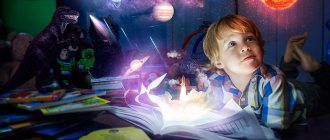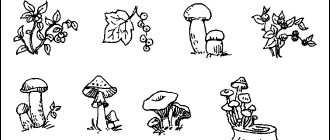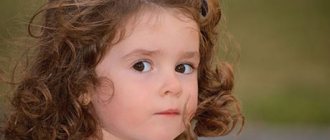What is imagination
Generally speaking, imagination is a person’s ability to recombine images. The essence of imagination is that it helps to “grasp” the whole before its parts. A person can create a complete image based on only a small hint.
A distinctive feature of imagination is a kind of alienation from reality, the formation of new images. A person does not simply reproduce ideas he already has, which is a common property of memory. Psychologists have different points of view as to why a person has the opportunity to build a new imaginary world.
D. Dewey wrote that children's imagination is richer than that of adults. And according to S.L. Rubinstein, children's imagination can only be assessed if it is compared with the rate of development of other mental processes.
Interest in this topic is due to the fact that researchers are faced with the task of determining how to most fully reveal the individuality of children and their creative potential. Modern life is constantly becoming more complicated. It takes on more and more diverse forms. And what is required of people today is not routine and habitual actions, as was the case centuries ago.
Children's need for creativity
Today, a creative approach to solving many problems is more important than ever. Members of society need to be able to independently set and solve new problems. Already when working with preschoolers, it is necessary to develop an active creative personality, capable of forming and developing independently.
In childhood, a person develops intensively. His consciousness is constantly undergoing change. He is constantly learning something new. His life consists of contradictions and paradoxes, without which it is impossible to imagine the process of personality formation.
This is especially evident in creative activities, which allows the child to fully reveal his own inner world. Creativity is considered as a meaningful form of psychological activity. This is a universal ability that ensures the successful performance of a wide variety of activities.
At preschool age, it is easiest to lay the foundations for the formation of creativity. It is during this period that the child experiences progressive changes. His mental processes develop, his personality qualities are actively formed, the child becomes more independent, his abilities and inclinations are formed.
conclusions
The modern world requires a person to be able to find non-standard solutions to problems. Already in elementary school, the child is faced with tasks that require a creative approach to successfully complete. Preschool age is considered the most favorable for the development of imagination. To do this, there are many games and exercises in which kids need to independently come up with something new and unusual. And don’t forget to set an example for your child, because children copy the behavior of adults: play and fantasize with your baby.
Creative activities in childhood
According to L.S. Vygotsky, in older preschool age a new form of activity appears - creative activity. The child takes initiative and is active in applying already learned techniques to new content. He learns to find original ways to solve given problems, learns to use different types of transformations, etc.
For a long time, classical education was based mainly on the use of a method based on reproductive activity. Teachers considered exploratory research as an auxiliary approach used in the pedagogical process.
Such an information-prescription approach leads to the fact that children lose their newly emerging ability to display search activity. This is due to the fact that their learning is mainly based on imitation and obedience. As a result, the child loses independence and is unable to think and create on his own.
Pedagogy today considers children’s ability to independently find the necessary information as one of the important features of a child’s behavior.
Formation of creativity in childhood
Preschool pedagogy contains many theoretical developments devoted to the formation of imagination in children's creativity. But to implement this in practice, few methodological scientifically based developments have been presented. Scientists L.S. studied the formation of imagination and its features in the preschool period. Vygotsky, V.N. Druzhinina, N. Zakharyuta and others.
When describing children's imagination as poor or rich, one must keep in mind that there are different points of view on this issue. Some argue that the imagination of preschool children is much richer than that of an adult. After all, children devote a significant part of their lives to fantasies.
Others believe that since the main source for imagination is the practical real experience of human life, then in children it takes on more primitive and poorer forms.
What types of imagination are there?
The brain is not only an organ that stores and reproduces our experience, but also combines, creatively processes and creates something completely new from the components of its experience. Creativity makes a person a being who looks into the future, which he creates by modifying his present. Creativity based on the combinatorial ability of the brain is called imagination .
In psychology, there are several classifications of imagination.
What types of imagination are there? Based on activity:
- active (active)
- passive (contemplative).
Based on independence and originality:
- recreating
- creative.
The basis of the recreating imagination is a person’s idea of something new, which is supported by a description or conventional image (diagram, drawing, notes, etc.).
The basis of creative imagination is the independent creation of completely new images without the help of a description or image.
Features of children's imagination
The question of how rich a child’s imagination is is considered quite difficult. There is an assumption that children's imagination is richer than that of adults. And in fact, children often love to fantasize: they love to make up stories, come up with fantastic plots, and can easily attribute human relationships and experiences to a stone or tree. They often talk to things.
But these elements that are included in children's fantasies are borrowed by them from real experience. For example, from fairy tales that they heard from their parents. Or from films seen or words heard.
In general, the basis for fantasy is always what the child encountered in his real life. New combinations of old images, transfer of events and properties from one character to another - all this allows you to create original fantastic pictures that are not similar to the real world.
But any fantastic combinations are built on the basis of real children's experience, on what they have already learned. And since children still have little knowledge, and they have poor life experience, there is much less material for imagination.
A child is able to imagine much less than adults. His imagination is limited to meager ideas about life, and is based on his primitive life experience. This means that a child’s imagination cannot be richer than that of an adult. It is much poorer.
But if we talk about the role that imagination plays in a person’s life, then it is much greater for children than for adults. Imagination manifests itself much more often in children, allowing them to seem to fly away from reality. A special feature of children's imagination is that they believe in what they come up with.
How creative imagination begins
The real and imaginary worlds do not have the same clear boundary for them as for adults. Emotional experiences in imaginary situations are as strong as if they were real. And these experiences are much stronger than those of an adult.
Children from three to five years old may well have the ability to mourn the loss of a bun or goat. They may begin to threaten the evil wizard in the play, even try to beat him, or come up with a way to save the bunny from the wolf. Imaginary space evokes a powerful flow of emotions in children. Children actually worry about what might become a threat to the imaginary character.
It is known that adults often, for educational reasons, introduce fictitious characters into the minds of children: evil heroes who can take away a naughty child. They also come up with good fairies who can give good gifts and work miracles. All these characters are real heroes for a child. They actually fear Baba Yaga and are waiting for the good fairy.
The main functions of children's imagination
From a very early age, children's imagination has two main functions: affective and cognitive. The main task of cognitive imagination is the mental reconstruction of reality, completing ideas about the world, and acquiring new impressions. Imagination allows children to creatively comprehend patterns of people’s actions and build holistic images of any events or phenomena.
The affective function of the imagination is associated with asserting and defending one’s own “I”. This protection can be achieved in different ways. Firstly, when a child reproduces a traumatic event many times. This allows him to kind of step back from it and see it from the outside.
Secondly, preschoolers produce imaginary situations in which they try to assert themselves. This helps them feel brave and strong, skillful and dexterous, even to some extent omnipotent. Many children's fantasies about victories and successes, for example, fantasies about how one can save Kai or Ivanushka, are based on this function.
When children imitate the actions of adults, they begin to use paper and pencils to create scribbles from an early age. Gradually, children move away from mindless scribbling and begin to understand the function of a pencil. This is how the child’s movements acquire the trait of awareness and precision. The period of visual activity begins.
Drawings appear in a child's life when he begins to associate his own scribbles with objects and consciously begins to create imaginary objects using a pencil on paper.
Useful games and exercises
You can activate the development of your child’s creative imagination by using useful exercises and games:
- "It's a reverse tale." Tell your child any fairy tale he knows. Let the child tell it so that everything is the other way around: for example, a hare is chasing a fox, Thumb Boy has become the size of an elephant, etc.
- "Fantastic animal." Invite your child to draw an animal that does not exist in nature. As an option: an unusual fairy-tale house, the kindest sorceress in the world.
- "New fairy tale". Let mom name one fairy-tale character (for example, Leopold the cat), and dad name another (Pinocchio). They must be from different works. Ask your child to compose a new fairy tale featuring these two characters.
- "Gnome". Tell your child: “Imagine that there is a little mischievous gnome sitting on our chandelier. Tell me, what does he see from above?
- "Unusual use." After telling the little inventor the name of some ordinary object (stick, telephone, glasses...), ask him to come up with an unusual way to use this object. By doing this exercise, parents themselves will practice developing their imagination.
- “Complete the drawing.” After drawing a squiggle on paper, invite your child to complete the drawing by drawing something according to his idea. Show how this is done with a personal example: a semicircle can turn into a mushroom, two parallel lines into a car, etc.
- "Imagine this". Play with your child: “Let’s imagine what would happen if it was raining candy canes now? What if mice talked? What if there were 4 people?
- "Imagine". Let the child imagine that he has become the king of England or a robot or a wizard or a giraffe... There are as many options as you like. Let him invent and imagine.
Video about how you can use an unusual book to engage your child, developing imagination and creativity
https://www.youtube.com/watch?v=Z_tWKUD9ASk
Visual activity and children's imagination
To begin visual activity, you can verbally formulate your intention. The desire to depict graphic images familiar to him is manifested in circle-like curves, with the help of which children depict an uncle or aunt, etc.
Over time, these pictures cease to satisfy children, and they begin to find new graphic images. This is how cephalopods appear on paper.
The big leap in a child’s development is also reflected in the change in the drawing process that occurs during the preschool period. With the help of adults, children begin to draw trees, houses, cars, flowers. The preschooler learns to overcome patterns and draws what interests him.
Children try to draw everything they can imagine and fantasize about. Many of them are interested in the fantasy world. They enjoy drawing princesses and wizards, sorcerers and fairies. Preschoolers also draw what happens to them in real life. Drawing takes the form of a game. With the help of visual activities, children master their social environment, as well as the world in which they live.
Fine art allows you to create fantastic images using elementary techniques. The child changes color, distorts shapes, and creates unusual arrangements of objects. These images are still poor and not expressive.
Valuable advice for parents
Valuable tips will help make the development of creative imagination effective:
- Use more visual examples. When talking about distant lands or magical heroes, show colorful images.
- Play games with fictional characters. This way the child will learn to think creatively and model a way out of various situations. Imagination will help you cope with even the most difficult circumstances.
- Find props. When portraying some characters with your child or preparing for a home theater performance, find elements at home that will help you better get used to the character. This will make it more interesting for the child.
- Allow a little creative chaos. Yes, sometimes you need to build something, construct something for the game. Try not to interrupt the creative flight of your child’s imagination.
- Praise for originality. Note the positive aspects that your child shows in play and creative activities.
- Listen with pleasure. Whatever your child comes up with and tells you, listen carefully and with joy. Support your child's impulse for creativity and imagination, and he will become a real creative person.
Imagination is one of the ways to understand the world. It was imagination that gave humanity comfort and coziness, civilization. Dear parents, consider the importance of developing imagination when organizing your child’s educational process. Do not forget that it is important to engage in its formation from an early age.
Age-related characteristics of creative imagination
The creative imagination of children has some age-related characteristics. It is noticeable that children in the same group can express themselves differently during creative activity. The images they create are also individual. When children create songs and fairy tales, dances and drawings, individual traits can be traced in all of this.
N.I. Strelyanova studied the individual characteristics of the creative imagination of preschool children in the visual arts. She identified four groups of preschoolers who differ in their individual manifestations in drawing: slow and fast converters, slow and fast recreaters.
Let's look at each of these types in more detail.
Slow converter
The child’s imagination is directed to transformation while working on appliqué and drawing. The child creates images slowly; he first thinks about them for a long time. Typically, these children work much longer to create their own appliques and drawings. The pictorial lines are thin and timid. But over time they become brighter and more confident. Moreover, the main images are clearly expressed, and the background becomes less saturated. Children are passionate about work and learn easily and quickly.
Fast converter
Imagination acquires a noticeable focus on transforming objects. The child quickly forms images. Preschoolers complete their applications and drawings much faster. They draw the line in the drawings sharply, pressing hard on the pencil. Hatching acquires lubricating properties. The brightness and sharpness of the coloring increases as the work approaches completion. The children work enthusiastically. Their actions are especially productive in the first minutes of class. They learn easily and quickly.
Slow Recreator
Children's imagination is directed towards reconstruction and repetition. Images are formed very slowly. Children generally work longer to create images than others their age. The pictorial lines are timid and thin, especially in the first works for each task. All image elements are the same in terms of pressure. The stroke is very neat. The main content is more brightly colored than the background. Children master visual arts at a slow pace.
Fast Recreator
In preschoolers, the imagination is directed towards repetition and reconstruction. Their images are formed quite quickly. The work is completed fairly quickly, on par with most peers. The line of the image is sharp, press the pencil hard. Hatching acquires lubricating properties. As the work gets closer to completion, the brightness and sharpness increases. At the same time, the learning process is slow.
Thus, preschool children exhibit different manifestations of creative imagination. Therefore, the conditions for their development in the future will be unique for any type of activity. By shaping imagination from the early stages of development, we not only have a positive impact on the processes of cognition and creativity, but also have a beneficial effect on the formation of children’s personality.
In children of senior preschool age, creative imagination has its own characteristics. Senior preschool age (6-7 years) is characterized as a period of significant changes in the child’s body and is a certain stage in the maturation of the body. At this age, all mental processes improve, including imagination.
Formation of creative imagination in children of senior preschool age
Compiled by:
Podlipaeva Natalia Sergeevna,
teacher of the first category
MAU DO "Sorokinsky Child Development Center -
kindergarten No. 1"
The article reveals the concept of creative imagination and the features of its formation in children of senior preschool age, suggests conditions and methods for developing creative imagination in children
Imagination and creativity are among the most powerful driving forces of modern society. In the process of creativity, emotional release occurs, the potential of the individual is revealed, bright ideas are born, and something fundamentally new is created [1].
The formation and formation of creative imagination occurs in childhood, therefore educational institutions are faced with the important task of developing the creative imagination of students of senior preschool age and creating a favorable soil for children's self-expression.
The main feature of the formation of creative imagination in children is its attachment to life experience and the surrounding reality. The child must learn to reflect objects and phenomena that he has encountered in life or independently invented through creativity. At the same time, the acquired knowledge and emotions can find expression in a variety of forms of art: drawings, dancing, writing poetry, fairy tales, etc. [3].
A child's imagination is fundamentally different from an adult's. Due to the absence of many of the thinking patterns characteristic of adults, children's creative imagination often seems free and very rich, but in reality this is not the case. The perception and processing of images characteristic of creativity are based on acquired knowledge and life experience. From this point of view, a child's imagination cannot in any way surpass an adult's. And the breadth of imagination is manifested only due to the lack of critical thinking characteristic of adults. In other words, children freely generate new ideas without fear of making mistakes [8].
Based on the types of activity, imagination is usually divided into:
- Active, in which images are created consciously and according to the child’s independent desire;
- Contemplative, which includes dreams, fantasies, dreams;
- Passive, forming images arbitrarily and spontaneously.
All of these types of creative imagination play an important role in a child’s life: they help to understand the world around them, fill gaps in knowledge and put together scattered, fragmentary or insufficient information about something.
It is at senior preschool age that children's imagination enters the active stage and develops into conscious creativity.
Conditions for the correct formation of creative imagination in children.
The makings of creative imagination are present in almost all preschool children, but it is not able to develop independently: for the successful and correct formation of a child’s creative personality, fertile soil is necessary [5].
Thus, at the initial stages, the formation of creative imagination in children is influenced by adults: parents and teachers help the child accumulate experience and push him to freely create images. In older preschool age, the child begins to express imagination independently, individualizing the process of his creativity as much as possible, relying only on his own knowledge and feelings.
One of the most important steps on the path to the correct formation of the imagination and unlocking the creative potential of a child, oddly enough, is his early physical development. So, gymnastics, swimming and other types of activities will help you gain experience and acquire a lot of new knowledge about the world around you.
In addition, the environment in which the child is located plays an important role. It is desirable that games, social circle and other areas of his life are slightly ahead of his own development, thereby stimulating an accelerated pace of familiarization with the environment and the rapid acquisition of new knowledge and skills [2].
Another necessary condition for the development of a child’s imagination is the freedom of his creativity. It is necessary to allow the child to independently choose the type of creative activity, alternate activities and control their duration. In a word, to create favorable soil for creativity, preventing the child from becoming overtired and the process of transforming imagination into active creativity begins to cause negative emotions.
It is the pleasure from the process of creating images in the imagination and their subsequent embodiment through creativity that is the key to full self-expression. At the same time, it is important to ensure that the nature of the creative process requires maximum concentration and tension from the child [7].
An important condition for the development of a creative personality and the realization of creative potential is a comfortable psychological atmosphere in which a child grows and develops. The task of adults is to provide the child with a sense of security, calm and support in the process of creative search. A preschooler should have enough free time for self-realization and self-expression. One should not criticize the manifestations of a child’s imagination and the results of his creativity, being patient with his inventions and accepting his creative failures with sympathy.
Ways to develop creative imagination.
There are several effective ways to form and subsequently fully develop a child’s imagination [3].
- Enrichment of life experience. The more a child knows, the wider the range of emotions he knows, the more varied and vivid his fantasies can be.
- Reading. Immersion in the world of books, travel to unknown places, meeting colorful characters - all this is a powerful stimulus for the development of imagination.
- Composition. Independently inventing stories and the ability to fill them with arbitrary details also contribute to the development of the child’s creative imagination.
- Drawing. Recreating invented images through fine art contributes not only to the activation of creative imagination, but also to the development of abstract logical thinking.
The formation of creative imagination in children of senior preschool age is important in the process of preparing a child for subsequent schooling, since in its absence educational activities cannot take place to the fullest extent. Thus, imagination helps to imagine objects and phenomena that the student has not encountered in real life: historical events, geographical objects, the interaction of chemical elements, etc. [8].
In addition, the development of a child’s creative personality is a significant contribution to his balanced psycho-emotional state. Even if a person is not endowed with outstanding talents in a particular form of art, expressing oneself through creativity allows one to throw out negative emotions, express one’s feelings, fears and experiences.
Thanks to imagination and subsequent attempts to convey imaginary images through art, the child develops memory, attention, learns to analyze, and create something new. During visual activities, the baby develops intuitive and spatial thinking, a sense of color and shape, and writing poetry or fairy tales contributes to the development of speech skills [4].
Such qualities of imagination as breadth, independence, brightness are formed only under the condition of systematic creative practices. Adults should monitor the regularity of this process, guiding and pushing the child to creativity if he is lazy. However, ready-made themes for imagination should not be imposed on the child: he must independently develop images, using only his own knowledge about the world around him.
Physical activities, educational games, special exercises - there are many opportunities for the development and proper formation of creative imagination in children of senior preschool age. However, in order to avoid spontaneous development of the child’s creative potential and achieve its high level, both parents and teachers should pay attention to systematic training in this area [6].
The development of creative imagination in older preschoolers helps broaden their horizons, improve cognitive processes, and develop the ability to think outside the box. Not only the creative potential, but also the entire process of interaction with the world around the child in the future largely depends on how developed these components are. Thus, the ability to think outside the box in adulthood helps to quickly find ways to solve problems and take a creative approach to overcoming life's difficulties.
BIBLIOGRAPHY
- Vygotsky L. S. Imagination and creativity in childhood [Text] / L. S. Vygotsky. — M.: “Prosveshcheniye”, 2011. — 124 p.
- Dudetsky, A.Ya. Theoretical foundations of imagination and creativity [Text] / A.Ya. Dudetsky. - Smolensk: Publishing House LLC, 2004. - P.214.
- Dyachenko, O.M. On the main directions of the formation of imagination in children [Text] / O.M. Dyachenko // Questions of psychology. -2007. -No. 16. — P.32.
- Zakaulova, N.A. Development of the creative imagination of older preschoolers in productive activities and artistic creativity [Text]/N.A. Zakaulova // Educational projects “Owlet” for preschoolers. – 2015. – No. 33. – ART 132601. – URL: https://www.kids.covenok.ru/132601.htm. - Mr. reg. El No FS77-55136. – ISSN: 2307-9282.
- Ivanova, A.A. Development of the creative imagination of older preschoolers [Text] / A. A. Ivanova, N. A. Shinkareva // Education and training: theory, methodology and practice: materials of the III International. scientific-practical conf. (Cheboksary, May 08, 2015) - Cheboksary: CNS Interactive Plus, 2015. - pp. 136–138.
- Kravtsova, E. Formation of imagination [Text]/E. Kravtsova // Preschool education. -2005. -No. 12. — P.17.
- Shinkareva, N.A. Pedagogical conditions for the development of creative imagination of children of senior preschool age [Text]/N.A. Shinkareva, A.V. Karmanova // Young scientist. - 2021. - No. 9. - pp. 1210-1213. — URL https://moluch.ru/archive/113/29439/ (date of access: 05/26/2019).
- Shinkareva, N.A. The essence of the concepts of “imagination”, “creative imagination” in psychological and pedagogical literature [Text]/N.A. Shinkareva // Young scientist. - 2015. - No. 24. - pp. 1053-1055. — URL https://moluch.ru/archive/104/24137/ (date of access: 05/26/2019).
“Certificate of publication in the media” Series A No. 0005892
We invite teachers of preschool education in the Tyumen region, Yamal-Nenets Autonomous Okrug and Khanty-Mansi Autonomous Okrug-Yugra to publish their teaching materials: - Pedagogical experience, original programs, teaching aids, presentations for classes, electronic games; — Personally developed notes and scenarios of educational activities, projects, master classes (including videos), forms of work with families and teachers.
Why is it profitable to publish with us?
1. “Kindergartens of the Tyumen Region” is an officially registered specialized media outlet at the federal level. 2. The activities of the editorial office are supported by the Department of Education and Science of the Tyumen Region 3. We issue a “Certificate of Publication” in the media. 4. The document has a unique number, is entered in the register, has the original seal of the editorial office of the online publication and signature. 5. “Certificate of publication” in the media is sent to the author in both paper and electronic versions.
Details >>>
Sample “Certificate of publication of author’s methodological material in the media.”pdf
Share
